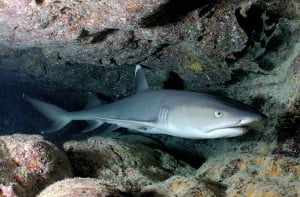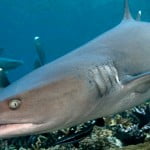The whitetip reef shark (Triaenodon obesus) is a species of requiem shark, family Carcharhinidae, and the only member of its genus. A small shark usually not exceeding 1.6 m (5.2 ft) in length, this species is easily recognizable by its slender body and short but broad head, as well as tubular skin flaps beside the nostrils, oval eyes with vertical pupils, and white-tipped dorsal and caudal fins. One of the most common sharks found on Indo-Pacificcoral reefs, the whitetip reef shark occurs as far west as South Africa and as far east as Central America. It is typically found on or near the bottom in clear water, at a depth of 8–40 m (26–130 ft).
Simple identification points:
- Rounded nose, white tip on dorsal fin (back fin) and tail fin
- Small; largest around 2 metres long
- Found on or near shallow coral reefs
- In daytime rests on sandy slopes and caves, sitting motionless
- At night feed on crabs, lobster, octopus and fish sleeping in holes in the reef
- Give birth to 1 – 5 live babies
- Stay within a few kilometers of their home range
During the day, whitetip reef sharks spend much of their time resting inside caves. Unlike other requiem sharks, which rely on ram ventilation and must constantly swim to breathe, this shark can pump water over its gills and lie still on the bottom. At night, whitetip reef sharks emerge to hunt bony fishes,crustaceans, and octopus in groups, their elongate bodies allowing them to force their way into crevices and holes to extract hidden prey. Individual whitetip reef sharks may stay within a particular area of the reef for months to years, time and again returning to the same shelter. This species isviviparous, in which the developing embryos sustained by a placental connection to their mother. One of the few sharks in which mating has been observed in the wild, receptive female whitetip reef sharks are followed by prospective males, who attempt to grasp her pectoral fin and maneuver the two of them into positions suitable for copulation. Females give birth to 1–6 pups every other year, after a gestation period of 10–13 months.
Whitetip reef sharks are rarely aggressive towards humans, though they may investigate swimmers closely. However, spear fishers are at risk of being bitten by one attempting to steal their catch. This species is caught for food, though there are reports of ciguatera poisoning resulting from its consumption. The International Union for Conservation of Nature (IUCN) has assessed the whitetip reef shark as Near Threatened, noting that its numbers are dwindling due to increasing levels of unregulated fishing activity across its range. The slow reproductive rate and limited habitat preferences of this species renders its populations vulnerable to over-exploitation.
Triaenodon Obsesus
Triaenodon obesus (Rüppell, 1837) CARCH Tria 1
Carcharias obesus Rüppell, 1837, Neue Wirbel.Faun.Abyssinien.Fische Rothen Meeres, (11):64, pl. 18, fig. 2.


Field Marks: A small, fairly slender grey requiem shark with brilliant, extremely conspicuous white tips (not entire posterior margins) on its first dorsal fin and upper caudal lobe (white tip sometimes present on the second dorsal, ventral caudal-lobe, and underside of the pectoral fins), lighter undersides shading gradually into darker dorsal coloration, an extremely short, broad snout, horizontally oval eyes with posterior notches, down slanted mouth and prominent brow ridges that give its face a sardonic, disgusted look, prominent expanded, tubular anterior nasal flaps, a large second dorsal fin that is still considerably smaller than the first dorsal, and small smooth-edged teeth with strong cusplets in both jaws.

Diagnostic Features: See genus. underside of head upper and lower tooth
Geographical Distribution: Wide ranging in the Indo-Pacific. Indo-West and central Pacific: South Africa and Red Sea to Pakistan, India, Sri Lanka, Burma, Indonesia, Viet Nam, Taiwan Island, Riu Kiu Islands, The Philippines, Australia (Queensland, north and Western Australia), New Guinea; widespread in Polynesia, Melanesia and Micronesia northward to the Hawaiian Islands and southwest to the Pitcairn group (see Randall, 1977 for details of the range of this species in Oceania). Eastern Pacific: Cocos and Galapagos Islands, Panama to Costa Rica.

Habitat and Biology: A common tropical inshore shark of the continental shelves and island terraces, frequently found in shallow, clear water, on or near coral reefs; often at depths of 8 to 40 m but up to a metre or less or exceptionally down to 110 m or even 330 m; commonly occurring on or near the bottom, in crevices or caves in coral reefs, and in coral lagoons. It Is often seen resting on the bottom, in caves and under ledges in coral and on sand. In Oceania, it is one of the commonest reef sharks, along with the blacktip reef shark, Carcharhinusmelanopterus and the grey reef shark, C. amblyrhynchos. It does not frequent extremely shallow reef and sandy areas like the blacktip reef shark, nor does it range well above the substrate and near outer dropoffs like the grey reef shark.
This is a bottom-oriented shark that superficially resembles the sharks of the genus Triakis in its active, undulating swimming pattern, and like some of these triakids seldom comes to the surface and is readily capable of sitting motionless on the bottom for long periods. Tagging studies (including sonic tagging) indicate that these sharks have a diel and tidal activity pattern, being most active at night and at slack tides where strong currents occur. They aggregate in caves during daytime but are often more active during slack tides. Their usual routine may be interrupted by learned behaviour in areas where much spearfishing occurs, as they tend to come out of their caves when spearfishing starts, and search for speared prey. Apparently the sound of spearfishing activities, or even a boat dropping anchor, cues the sharks and arouses them.
Individual whitetip reef sharks return to the same caves in the day for long periods, but preferences for caves change periodically with given individuals, so that they vacate a given cave and rest in another after some time. These sharks have a narrow home range for their daily activities and can remain in a given small area for months or even years, but eventually may quit an area and wander for a time before fixating on a new area. Apparently these sharks are not territorial, but share their home range with other members of their species and other sharks without conflict. Distances travelled by given individuals have been from 0.3 to about 3 km in periods up to about a year, and an estimation of the sizes of home ranges of these sharks has been given as several square kilometres.
Data on growth in this species are limited, but from estimations by Randall (1977) the reef whitetip may take at least 5 years to reach maturity, and reach a maximum age of at least 25 years.
Viviparous, with 1 to 5 young per litter (commonly two or three). In French Polynesia, this shark apparently gives birth in autumn or winter, May to August, while at Enewetak Atoll they may give birth in July. Data, from Randall (1977) from mature female sharks from Johnston Island and Enewetak Atoll suggests that this shark has a gestation period of at least 5 months, but this needs to be confirmed.
Unlike many carcharhinids, this shark is an inept pelagic predator, but is an efficient specialist in capturing bottom prey in crevices, holes and caves in coral heads and ledges. It apparently orients to olfactory and sonic cues but may have considerable difficulty finding cut baits. One or more whitetips may pursue a wounded, speared fish headfirst into a hole or crevice, and attempt to grab it. If they fail to immediately capture it they may rest with their bodies half out of the hole the prey is in, but sooner or later one will grab the prey. The shark then thrashes until it extracts or dismembers its victim. It feeds primarily on bony fishes, including eels (a moray was found in one), squirrelfishes, snappers, damselfishes, parrotfishes, surgeonfishes, triggerfishes, and goatfishes and octopi, but also spiny lobsters and crabs. One whitetip reef shark was found in the stomach of a giant grouper, and it is likely that other, larger carcharhinid sharks prey on it.
The whitetip reef shark often does not react to swimmers or divers unless approached, in which case it flees or keeps a distance between itself and the people involved. When spearfishing, other fish-collecting activity or deliberate baiting to lure sharks for photography is done by divers near the bottom where this shark occurs, it is readily attracted and seeks out potential food sources. Although whitetips may approach divers very closely under such conditions, they are rarely aggressive, and divers have been able to feed them by hand. On rare occasions, whitetips have bitten divers, but apparently in self-defence when molested, and especially when excited during spearfishing bouts. For example, Randall (1977) was attacked by one that he had speared and pursued. Other divers have had to repeatedly fend off excited and apparently attacking whitetips while contesting speared fishes, with them. One spearfishing diver was bitten in the leg by a whitetip that had come up behind him, but was not greatly injured. Its small size, small teeth, and generally placid and unaggresive behaviour makes it far less dangerous than many other carcharhinids, but even this shark can be stimulated into attacking, like a domestic cat or dog. Randall (1977) regards the possibility of ciguatera poisoning from eating the meat of the whitetip as more of a danger than attack by it, although areas where whitetips are toxic are few and sporadic.
Size: Maximum said to be about 213 cm but adults are very rare over 160 cm; males maturing at about 104 to 105 cm and reaching 168 cm, females maturing at 105 to 109+ cm and reaching at least 158 cm; size at birth about 52 to 60 cm.
Interest to Fisheries: Details of fisheries involving this species are sketchy. It is apparently fished off Pakistan, India, Sri Lanka and Madagascar, and probably elsewhere where it occurs. It is fished with floating and fixed bottom gillnets and longlines, and its meat and liver utilised fresh for human consumption.
Literature: Beebe & Tee-Van (1941); Fowler (1941); Wheeler (1960); Fourmanoir (1961); Gohar & Mazhar (1964); Bass, D’Aubrey & Kistnasamy (1975b); Taniuchi (1975); Randall (1977); Johnson (1978); Compagno (1979).
Remarks: Randall (1977) presented a comprehensive. survey of the life-history of this species, with a detailed review of its distribution.
The characters said by Whitley (1939) to separate his T. apicalis from the wide-ranging T. obesus apparently do not hold (Taniuchi, 1975; Bass, D’Aubrey & Kistnasamy, 1975b; Randall, 1977; Compagno, 1979), nor do eastern Pacific representatives of the species differ significantly from Indo-West Pacific sharks (Compagno, 1979).
from FAO SPECIES CATALOGUE
Vol.4. Sharks of the world
An annotated and illustrated catalogue of shark species known to date















